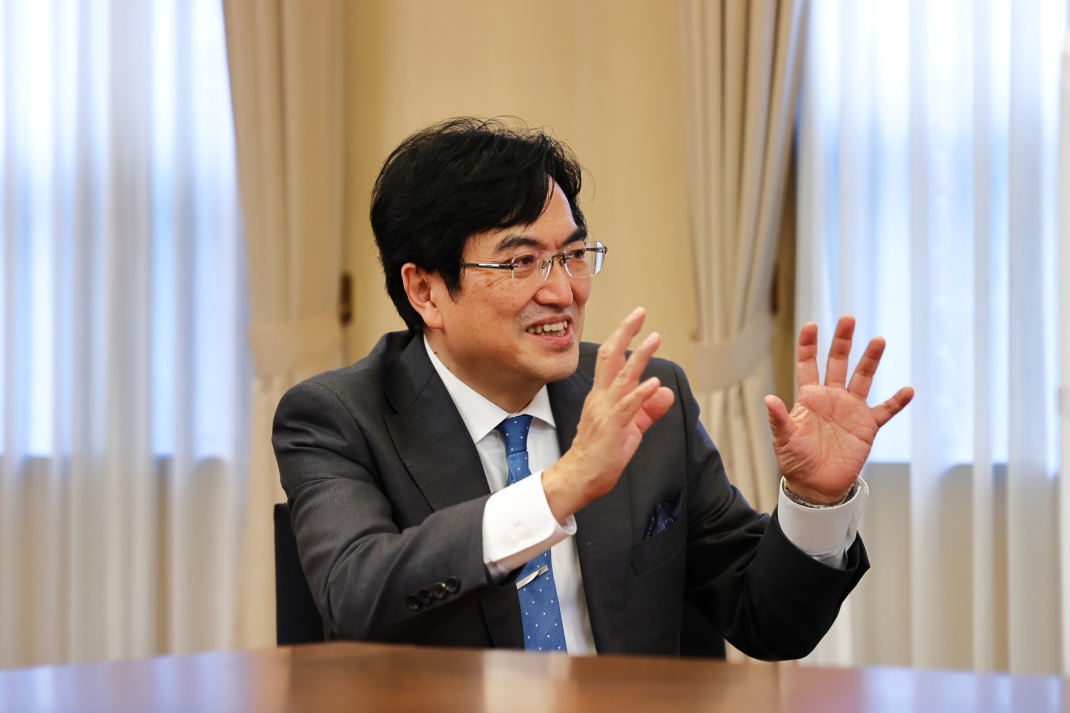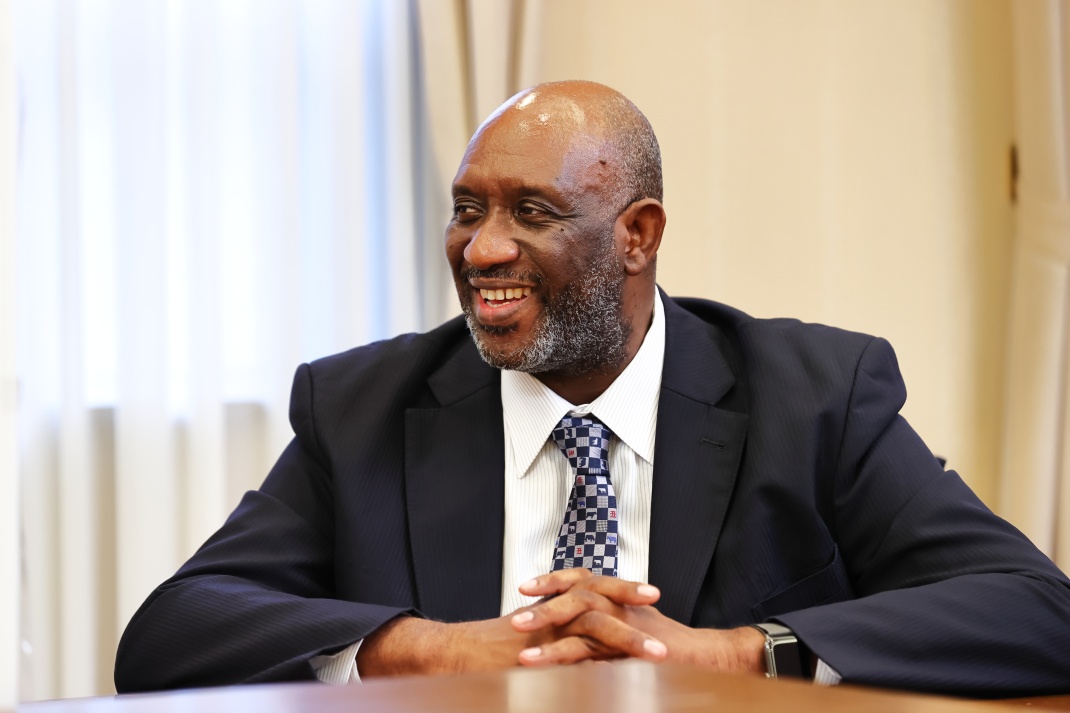Talk between Kyoto Seika University President Oussouby Sacko and Rikkyo University President Renta Nishihara
Rikkyo University
Dec 20, 2021
OVERVIEW
Kyoto Seika University President Oussouby Sacko, the first president of a Japanese university from an African country, and Rikkyo University President Renta Nishihara, who assumed the post in 2021, both studied at the Faculty of Engineering of Kyoto University, though they were there at different times. They discussed a wide range of topics, such as their student days, university administration, issues of education in Japan, and global education. The following is an excerpt of their talk.
Sacko: “A community whose members can annoy each other with peace of mind”

Rikkyo University President Renta Nishihara
Sacko: Thank you very much. I am honored to see you, too.
Nishihara: In my student days, I was doing volunteer work in the Higashikujo area of Kyoto, where many Korean residents in Japan live. In those days, they lived in huts built on the bank of Kamogawa river. Through the experience, I learned the meanings of “human dignity,” “a society where the values of each individual are respected” among others. Kyoto Seika University has “great respect and regard for humanity” and “the spirit of freedom and autonomy” as its philosophy. Prof. Sacko, you once again reconfirmed its founding philosophy when you assumed its presidency, and since then have been running the university based on that philosophy.
Sacko: Since social situations today have changed drastically from the past, the university, in some cases, provides a kind of education far from the founding philosophy. However, I thought the university’s raison d’etre might be called into question if it deviates too much from its original philosophy. When I took office, it happened to be the 50th anniversary of the university, so I reread the Memorandum of Foundational Education Principles advocating “great respect and regard for humanity” and “the spirit of freedom and autonomy” presented by the first president of the university. I was surprised to find that its content is not outdated and is still relevant today. At the same time, I recognized the university has not yet realized some fundamentals such as “great respect and regard for humanity” and decided to cement our foundation first.
Nishihara: Your university has a great philosophy. It is essential to reconfirm that it is still modern enough to apply today.

Kyoto Seika University President Oussouby Sacko
Nishihara: Do you mean you were able to build relations with them, like “grins” in the Republic of Mali, your home country?
Sacko: Yes. Let me explain about grins. In Mali, boys are circumcised around the age of 13. It is a rite of passage. A group of about a dozen boys circumcised together is called a grin; a sort of “eternal comradeship.” Members of a grin talk about everything with each other and grow up together. It is a community whose members can annoy each other, but put up with it. When I came to Japan, I looked for something equivalent to grins in Japan, but felt that a university might be too formal. So I invited members of the international exchange group and colleagues of my laboratory for meals and chatted with them, thereby building mutual relations gradually.
Nishihara: What I find appealing in the grin culture is that it is not a superficial friendship. It is different from the Japanese cultural practices of not causing trouble to others and reading the situation. In the grin culture, members can speak their minds and disagree with each other, in some cases. They can express their genuine opinions because they respect each other. Japanese students need a community like the grin.
Sacko: The relations with friends I have made in my student days are ongoing. We are still annoying each other with peace of mind.
Sacko: “Don’t set a goal for students. Students should find their own goal while studying”

Sacko: We might not trust students completely. In reality, however, students can do a surprising number of things if we leave things up to them. Rather than setting a goal for them, it means more if students find a goal while studying. I think teachers today worry about students too much. It might be because they believe they need to enable students to find jobs in four years. I feel that the whole Japanese society is in a hurry.
Nishihara: I feel we take it for granted since we are immersed in the ambiance of Japanese society. In choosing a university to enter, students may put importance on its job placement rate, whether it has an established reputation and its deviation value. I get the impression that many of them do not consider what they would like to study and how they would like to live. You remind me of the significance of the original point, which I tend to forget.
Nishihara: “Each student has rich potential that cannot be measured with a single value”

Nishihara: Metrics to rank universities, such as job placement rate or global competitiveness, are important in their own ways, but more important is to trust every student and let their respective values shine. We should steer universities toward utilizing the richness of each university and nurturing students by cooperating as a team. Here I would like to quote again from your book: “The education system in Japan seems to focus on producing ‘a useful person,’ but that is totally different from education that helps students lead a satisfying life.” This is also a significant message.
Sacko: Well, I have been saying whatever I would like to. (laughs)
Nishihara: Prof. Sacko, you have also said: “Education exists to make an individual happy. Then, what is ‘happiness’? Since its standard is different depending on nations, regions, ethnicities and individuals, there is no definite concept, image or right answer.” This is also important, isn’t it? It’s strange to standardize the concept of happiness. Words such as “diversity” and “inclusion” are used very often today, but I wonder what the much-touted “diversity” really means in that context.
Sacko: I fear that even “diversity” might be formatted. Japanese society cannot feel at ease unless it formats everything. Of course, it is all right to format something to a certain extent, but there must be some unformatted parts left where there is room for them.
Nishihara: We feel at ease if procedures are compiled into a manual. Then, we can expect that some products would be manufactured on an assembly line based on a manual, just like a factory. However, that is not education at all. There is a tendency in Japan to expect universities to nurture “strong and competitive workers.” But I believe each student must have abundant individuality, which cannot be measured with only one value.
Sacko: I agree with you. It is important to acknowledge a different way of living for each individual.
Nishihara: “Create a place to let students stay lively and shine”
Sacko: In the background of this remark is my experience of taking students to slums in India. Their residences are unimaginable according to the standard of modern architecture we are studying. However, they are built with structures beyond our knowledge. We need to learn from such “wisdom.”
Nishihara: You also referred to globalization and said,‘Japan is trying to ride a wave of globalization, but what feelings do its people have toward international students and workers?’ It’s a penetrating question. You assert: “Some people believe international workers need only a crash course learning the Japanese language and culture at the minimum level necessary to work in Japan. But it is impossible to import only labor power. People with labor power always have their cultures and religions with them. They have values and hearts, too.” I want to share this viewpoint with students, teachers, and employees of Rikkyo University by all means.
Sacko: At a welcome party for new students at Kyoto Seika University, I had an opportunity to talk with a Chinese student. She was born in Hungary and raised in Italy and can speak five languages. We tend to consider students from abroad as vulnerable people. However, some of them have seen far more of the world than most of us and have broader views and stronger wills. We must stop seeing them as a mass under the name of “international students” and become keenly aware that each one of them is different.
Nishihara: After all, it is fundamental that we must respect diversity and various values, trust every single student and support them to realize their freedom and happiness. That is not easy, but it would be a pleasure for university faculty to create a “space” where students could spend a lively time and shine. I will administer the university with that in mind. Thank you very much for today.
Sacko: I have enjoyed talking with you. Thank you.

Profiles
Kyoto Seika University President Oussouby Sacko
Rikkyo University President Renta Nishihara
RECENT TOPICS
Oct 17, 2025
MSDA Rikuzentakata Field Trip 2025
Master of Social Development and Administration (MSDA) Course